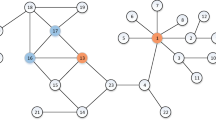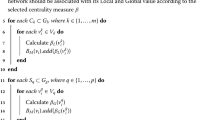Abstract
How to evaluate the importance of nodes in networks and detect the centrality has become a vital problem in improving the efficiency of telecommunication and making a disease immunity strategy. We consider the mechanisms of real networks, and define a cost function to describe different hierarchies of networks to measure node importance. This method takes up a node’s regional influence as well as its global influence to evaluate its importance. The results of simulation prove that this method is proper to describe effectively and detect node discrepancies in a network.
Similar content being viewed by others
Explore related subjects
Discover the latest articles and news from researchers in related subjects, suggested using machine learning.References
Watts D, Strogatz S. Collective dynamics of small-world networks. Nature, 1998, 393(6684): 440–442
Albert R, Jeong H, Barabas A L. Error and attack tolerance of complex networks. Nature, 2000, 406: 378–382
Barabasi A L, Albert R. Emergence of scaling in random networks. Science, 1999, 286(5439): 509–512
Albert R, Jeong H, Barabasi A L. Diameter of the world-wide web. Nature, 1999, 401: 130–131
Albert R, Barabasi A L. Statistical mechanics of complex networks. Reviews of Modern Physics, 2002, 74: 47–97
Newman M. The structure and function of complex networks. SIAM Review, 2003, 45: 167–256
Goh K, Oh E, Kahng B, Kim D. Betweenness centrality correlation in social networks. Physical Review E, 2003, 67: 017101
Albert R, Barabasi A L. Topology of evolving networks: local events and university. Physical Review Letters, 2000, 85(24): 5234–5237
Freeman L. A set of measures of centrality based upon betweenness. Sociometry, 1977, 40(1): 35–41
Freeman L. Centrality in social networks: conceptual clarification. Social Networks, 1979, 1(3): 215–219
Freeman L, Roeder D, Mulholland R R. Centrality in social networks: ii. experimental results. Social Networks, 1979, 2: 119–141
Brandes U. A fast algorithm for betweenness centrality. Journal of Mathematical Sociology, 2001, 25(2): 163–171
Estrada E, Rodriguez-Velazquez J A. Subgraph centrality in complex networks. Physical Review E, 2005, 71: 056103
Newman M. A measure of betweenness centrality based on random walk. Social Networks, 2005, 27(1): 39–54
Klovdahl A S. Social networks and the spread of infectious diseases: the AIDS example. Social Science & Medicine, 1985, 21(11): 1203–1216
Barthelemy M. Betweenness centrality in large complex networks. The European Physical Journal B, 2004, 38(2): 163–168
Tan Y J, Wu J, Deng H Z. Evaluation method for node importance based on node contraction in complex networks. System Engineering-Theory & Practice, 2006, (11): 26–35
Author information
Authors and Affiliations
Corresponding author
Rights and permissions
About this article
Cite this article
Rong, L., Guo, T. & Zhang, J. A new centrality measure based on sub-tree. Front. Comput. Sci. China 3, 356–360 (2009). https://doi.org/10.1007/s11704-009-0046-y
Received:
Accepted:
Published:
Issue Date:
DOI: https://doi.org/10.1007/s11704-009-0046-y




